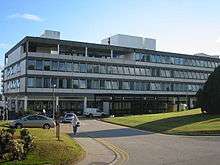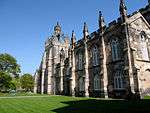University of Aberdeen School of Medicine and Dentistry
Aberdeen University School of Medicine, Medical Science & Nutrition is the medical school in the College of Life Sciences and Medicine at the University of Aberdeen in Scotland. It also provides training in medical sciences, nutrition, public health, dentistry, health sciences, physician associate studies at BSc, MSc, and PhD levels. The current school was formed from the merger of the former School of Medicine & Dentistry, School of Medical Sciences, and the Rowett Institute of Nutrition.
| Type | Medical school |
|---|---|
| Established | 1497 |
| Head of School (interim) | Paul Fowler |
| Students | ~ 850 |
| Location | Aberdeen , Scotland |
| Campus | Foresterhill Campus |
| Affiliations | University of Aberdeen |
| Website | The School of Medicine, Medical Science and Nutrition |
Medicine has been taught at the university since the founding of King's College in 1495. The formal establishment of a medical school supporting a broad curriculum appears to postdate 1787 when there were calls "for the establishment of a medical school" in Aberdeen.[1]
Education

The Institute of Education for Medical and Dental Sciences is part of the School of Medicine, Medical Sciences and Nutrition in the College of Life Sciences and Medicine. It is responsible for all of the education and teaching activities of the School. Its current Director is Prof Rona Patey, an anaesthetist. The Deputy Director is Prof Gordon McEwan, a physiologist. Scholarship-focused academic staff within the School mostly fall within this institute. The school’s education and teaching activities take place across both the Foresterhill Medical Campus, the University's main Old Aberdeen Campus, and Aberdeen Sports Village.
Locations
May2005.jpg)
Today, the school is based in the Suttie Centre for Teaching & Learning on the Foresterhill campus in Aberdeen, as well as the Institute of Medical Science, Dental Institute, Biomedical Physics Building, Health Science Building, Polwarth Building, Rowett Institute (all in Foresterhill Campus) and in the Centre for Health Science in Inverness. Laboratory and science teaching also takes place in Old Aberdeen, with a new Science Teaching Hub currently under construction for the use of biomedical students. Undergraduate clinical placements are mainly in hospitals but also in general practice and community settings. The variety of placements offered, both within Aberdeen and in other locations in the Highlands and Islands, allows students to gain experience of both inner-city medicine and to see how healthcare is delivered in areas far removed from large teaching centres.[4]
The main teaching hospitals are in Aberdeen: Aberdeen Royal Infirmary, Aberdeen Maternity Hospital, the Royal Aberdeen Children's Hospital, Woodend Hospital and the Royal Cornhill Hospital.
Teaching is also provided in Inverness: mainly at Raigmore Hospital and also New Craigs Hospital. Elgin: at Dr Gray's Hospital. In Fort William: Belford Hospital. In Stornoway, Isle of Lewis: Western Isles Hospital. In Kirkwall, Orkney: Balfour Hospital. In Lerwick, Shetland: Gilbert Bain Hospital. In Wick: Caithness General Hospital
Medical science courses are offered in physiology, pharmacology, neuroscience, anatomy, biochemistry, molecular biology, genetics, immunology, developmental biology, and sport science. Optional courses include an industrial placement and biobusiness training.
People
The interim Head of School is Professor Paul Fowler.[5] There are four active Regius Professorships, in Medicine, Physiology, Surgery and Anatomy. The Regius Chair of Midwifery is in abeyance.
Courses
The University of Aberdeen offers undergraduate courses in medicine (MB ChB), dentistry (BDS) and BSc programmes in Medical Sciences.[6] In 2018, the school had an intake of 184 students to study medicine; of these 18 came from outside the UK.[7]
Aberdeen offers a five-year MBChB programme, leading to the award of the degrees of Bachelor of Medicine and Bachelor of Surgery, MB ChB. The course uses a systems-based, integrated approach to teaching.[8]
The school offers the opportunity to undertake a further year of study to gain an intercalated BSc (Hons) in Medical Sciences or Medical Humanities.[9]

The school also offers Medical Science graduates the opportunity to study in Medicine, Dentistry or the Physician Associate programme.[6] Postgraduate degrees are offered as taught courses, generally leading to the degree of Master of Science (MSc), and as research degrees either at a master's (MSc, MRes, ChM) level or at doctoral (PhD, MD) level.[10]
Medical Society (Medsoc)
Aberdeen Medsoc was a society set-up originally to bring medical students together in a social capacity. It is the oldest Aberdeen University Student Society and today it has over 600 members. Annual social activities include Beerienteering, Medsoc Ball, Doctors v Medics Sports Day, Medsoc Revue and most recently a Fashion Show with proceeds going to a local children's charity.
There are a range of societies and groups that are open to medical and dental students, catering for a variety of interests.[11]
Famous alumni
- Robert Brown – discoverer of Brownian motion
- Sir Graeme Catto — president of the General Medical Council
- John James Richard Macleod — co-discoverer of insulin and Nobel Prize winner
- Sir Patrick Manson — "Father of Tropical Medicine"
- Professor Alex Mowat – pioneer of paediatric hepatology
- Sir Alexander Ogston — discoverer of Staphylococcus aureus
- The Very Reverend Gordon McPhate – Dean of Chester Cathedral
- Surgeon Major Peter Shepherd – pioneer of first aid for civilians.
References
- A complete collection of the papers ... - Google Books
- "Health Economics Research Unit". University of Aberdeen. Retrieved 9 October 2009.
- "Health Services Research Unit". University of Aberdeen. Retrieved 9 October 2007.
- "Study here: undergraduate: medicine". University of Aberdeen. Retrieved 16 June 2014.
- "Key People". University of Aberdeen. Retrieved 24 April 2019.
- "Undergraduate Study". University of Aberdeen. Retrieved 4 July 2017.
- "Admissions Data". University of Aberdeen. 2018. Retrieved 24 April 2019.
- "Study Medicine (MBChB)". University of Aberdeen. Retrieved 24 April 2019.
- "Intercalating". University of Aberdeen. Retrieved 24 April 2019.
- "Research". University of Aberdeen. Retrieved 4 July 2017.
- "Registered student societies". School of Medicine and Dentistry, University of Aberdeen. Retrieved 27 April 2014.
